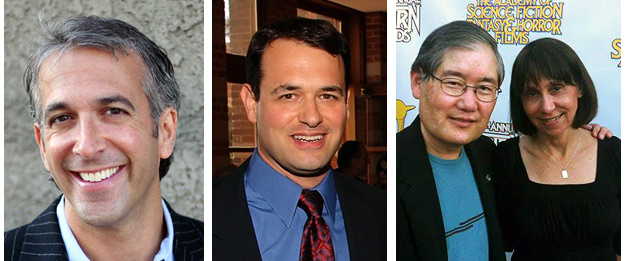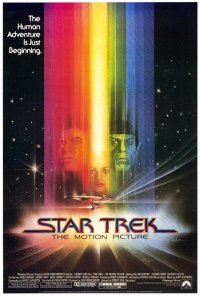“Star Trek: The Motion Picture provided a unique experience, leaving some audience members, myself included, elated at the prospect, “The Human Adventure Is Just Beginning.” — Robert Meyer Burnett
“I do feel very lucky to have been a kid while this amazing renaissance of fantasy filmmaking was going on.… Star Wars, then Close Encounters, then Superman, then Alien, then Star Trek: The Motion Picture… at least in terms of going to the movies, those are two-and-a-half years I wish I could experience again. It was a truly magical time.” — Mike Matessino [Read more here...]
The Digital Bits is pleased to present this retrospective commemorating the 35th anniversary of the release of Star Trek: The Motion Picture, the first big-screen adventure of the crew of the USS Enterprise. This serves as a companion piece to our recent interview with film historian and author Preston Neal Jones about his newly-published book on the making of the film. This time around we feature a Q&A with an esteemed group of Star Trek authorities who began as fans and are now film industry professionals (with credits on Star Trek-related projects) and we discuss the virtues and shortcomings of Star Trek: The Motion Picture and examine whether or not the film has endured. (The interviews were conducted separately and have been edited into a “roundtable” conversation format.)
Okay, let’s (alphabetically) meet the participants…
Mark A. Altman co-wrote and co-produced Free Enterprise, the beloved Star Trek-inspired cult classic starring William Shatner, as well as The Specials and DOA: Dead or Alive. In addition, he has been a writer and producer on several television series including Castle, Necessary Roughness and Femme Fatales, which he co-created. He is the founding publisher of Geek magazine and was the editor-in-chief of Sci-Fi Universe magazine. His books include Charting the Undiscovered Country: The Making of Trek VI (Cinemaker, 1992; co-authored with Ron Magid and Edward Gross), Great Birds of the Galaxy: Gene Roddenberry and the Creators of Trek (Boxtree, 1994; co-authored with Edward Gross) and Trek Navigator: The Ultimate Guide to the Entire Trek Saga (Back Bay, 1998; co-authored with Edward Gross). His new book, The Fifty Year Mission, co-written with Edward Gross, is an oral history of the Star Trek franchise and will be published in 2016 by St. Martin’s Press.
Jeff Bond is the author of The Music of Star Trek (Lone Eagle, 1999). He also wrote Danse Macabre: 25 Years of Danny Elfman and Tim Burton (included in The Danny Elfman & Tim Burton 25th Anniversary Music Box, Warner Bros., 2011) and is co-author with Joe Fordham of Planet of the Apes: The Evolution of the Legendary Franchise (Titan, 2014). Jeff is the former editor of Geek magazine, covered film music for The Hollywood Reporter for ten years, and has contributed liner notes to numerous CD soundtrack releases. He also has portrayed Dr. McCoy on the Star Trek New Voyages: Phase II Internet series.

Neil S. Bulk is a music editor and soundtrack producer. He co-produced Star Trek: The Original Series Soundtrack Collection and was involved with over 150 other CD soundtrack/original score releases including the Lethal Weapon Soundtrack Collection, North by Northwest, The Blue Max, and Dennis the Menace. He recently was hired by Bruce Botnick (the executive producer on the original Star Trek: The Motion Picture soundtrack album) to edit The Legacy Collection release of The Little Mermaid. Neil also appeared as a cadet in J.J. Abrams’ first Star Trek film.
Robert Meyer Burnett directed, co-wrote and edited Free Enterprise and co-produced and edited the supplemental material for the Blu-ray season sets of Star Trek: The Next Generation and Star Trek: Enterprise. He has worked as a consultant for Star Trek: The Experience at the Las Vegas Hilton. He co-produced Agent Cody Banks and The Hills Run Red, as well as directed and edited several episodes of the Cinemax series Femme Fatales. He is the owner of Ludovico Technique, which specializes in the production of Value Added Material for DVD and Blu-ray releases. He has produced VAM for titles such as The Usual Suspects, Superman Returns, X-Men, and The Chronicles of Narnia: The Lion, The Witch and the Wardrobe.

Daren R. Dochterman was the Visual Effects Supervisor on The Director’s Edition of Star Trek: The Motion Picture. He has worked in the motion picture industry for nearly thirty years and has over 65 motion picture credits as a concept designer and production illustrator, storyboard artist, visual effects artist, and art director. He’s been a director, editor, sound man, model builder, compositor, and actor. He also is an instructor of 3D modeling and architectural rendering at Art Center College of Design in Pasadena, California.
David C. Fein worked with filmmaker Robert Wise for several years and is the award-winning producer of The Director’s Edition of Star Trek: The Motion Picture. He is a pioneer in the field of special edition bonus features and produced the acclaimed documentaries on the making of Alien, The Last Starfighter, The Guns of Navarone, and others. He supervised audio restoration work for the Jay Ward animation catalog and has produced graphic design for numerous soundtracks and video productions. His articles on visual effects and computer technology have appeared in Cinefex and other publications.
Scott Mantz is the Film Segment Producer and resident Film Critic for Access Hollywood and Access Hollywood Live. Prior to Access Hollywood, Mantz worked for nine years as the Controller and Stage Show Manager for Creation Entertainment, where he traveled all over the country hosting Star Trek conventions. In addition to reviewing movies and providing awards season analysis for The Today Show, KNBC and the PBS review series Just Seen It, Mantz also hosts and produces Profiles, the weekly YouTube & iTunes film series that spotlights the greatest filmmakers of all time. He is the winner of the 2014 Press Award from the ICG Publicists Guild.
Mike Matessino was the Restoration Supervisor for The Director’s Edition of Star Trek: The Motion Picture and worked with producer/director Robert Wise from 1993-2005. In 2012 he produced, with Bruce Botnick, for La-La Land Records a 3-CD expanded score release of Jerry Goldsmith’s music for Star Trek: The Motion Picture. His other soundtrack credits as producer, mixer, mastering engineer or liner notes writer include Empire of the Sun, 1941, Poltergeist, Alien, Gremlins, The Goonies, Back to the Future, Home Alone, Superman, and the Star Wars Trilogy. He has directed behind-the-scenes documentaries on The Sound of Music, Alien, John Carpenter’s The Thing, and The Last Starfighter.

Denise Okuda was Video and Computer Playback Supervisor for Star Trek: Deep Space Nine, Voyager, Enterprise, and four Trek movies. In another universe, she worked on promotion for Buckaroo Banzai. Along with husband Michael, Denise is co-author of The Star Trek Encyclopedia (Pocket, 1997) and Star Trek Chronology: The History of the Future (1996). She’s also recorded audio commentaries for numerous Star Trek DVDs and Blu-rays. Denise is an ardent fan of the National Football League and spends way too much time watching the Red Zone Channel.
Michael Okuda’s work on Star Trek has earned him screen credit on more episodes and movies than anyone except Gene Roddenberry. Mike was Lead Graphic Designer for Star Trek: The Next Generation through Enterprise and has been nominated three times for the primetime Emmy for Outstanding Visual Effects. His NASA work includes the crew patch for the STS-125 space shuttle mission to the Hubble Space Telescope, and he has been honored with NASA’s Exceptional Public Service medal. As a tech consultant to Star Trek, he “invented” the Heisenberg compensator to answer those who foolishly believe the transporter is impossible.
Denise and Michael are both members of the Art Directors Guild. They recently served as visual effects consultants to CBS for the high-definition remastering of Star Trek: The Next Generation and the original Star Trek series. They live in Los Angeles with their dogs, Amber Joy and Scooter T. Rocketboy.
And now that the participants have been introduced, I suggest cueing up Jerry Goldsmith’s revered Star Trek: The Motion Picture score and enjoy the conversation with these Treksperts.
----
Michael Coate (The Digital Bits): In what way is Star Trek: The Motion Picture worthy of celebration on its 35th anniversary?
Mark A. Altman: It’s been said elsewhere and I think it’s no less true today than it was 35 years ago that in many ways Star Trek: The Motion Picture is the only true motion picture in the Trek franchise, and not a glorified TV episode, with the exclusion of the recent Abrams movies. It was the only film that had a real budget (until Nemesis, and you see how that turned out) and that is reflected in the scope of the film. The Enterprise feels like a real starship, well-populated and vast. Fans always point to the drydock scene as infusing the iconic starship with life, but it’s just as true once the shuttle pod docks and Kirk finds himself in a massive cargo bay and proceeds into the corridors of the ship, teaming with extras, going about their business. The film, for all its flaws, was also infused with real heady sci-fi ideas, the concept of artificial intelligence attaining consciousness that was way ahead of its time. In fact, the notion of a machine planet with sentience was so out there for the studio at the time that they tried to strike the concept from the film forcing Roddenberry to turn to his friends like Isaac Asimov to make a case that such evolution of artificial intelligence was actually possible. While ST:TMP may not be the best Star Trek movie, I believe it probably is the best Star Trek film. It’s a strange and subtle distinction, but it’s true. Certainly, Star Trek II is a more entertaining and fun movie, but it doesn’t have the scope and sense of awe and wonder of ST:TMP, nor do any of the films that followed it. True to the unemotional Mr. Spock, it is a film that engages the intellect and not the heart.
Jeff Bond: It was a huge development in the Star Trek franchise that really gave rise to everything that followed—it created the visual look for the entire series of movies, including the two J.J. Abrams films, and laid the groundwork for The Next Generation and all the subsequent TV series. It’s a beautifully designed film, and I think Jerry Goldsmith’s score is still one of the greatest ever written and certainly a high water mark in his career.
Neil S. Bulk: Star Trek: The Motion Picture is worthy of a 35th anniversary celebration because it returned Star Trek to the world. It’s also worth celebrating, because in all of Star Trek there isn’t another movie or TV series like it. This was a big-budget epic feature where no expense was spared. Everything (with the exception of Uhura’s earpiece) was built specifically for this movie. The scale is enormous, both physically and intellectually.
Robert Meyer Burnett: If nothing else, The Motion Picture ensured the future success of the entire Trek franchise. Had the film not worked, had it not been an enormous financial success, Trek would’ve ended right there, probably lying dormant for decades until this current climate of reboots and re-imaginings made the return of Trek possible. The decision to bring back the original cast, creating an expanding “In Universe” continuity between the end of The Original Series and the beginning of the feature, also remains one of the great, mostly-overlooked elements of TMP. Roddenberry carried this idea much further in The Next Generation, setting the series almost 100 years after TOS, allowing viewers and the fan base to enjoy a much richer experience with all the historical backstory.
Daren R. Dochterman: Star Trek: The Motion Picture still towers over the subsequent Trek films in several ways. Its vision and scope have never been matched. The subtlety of performances by all the cast are quite impressive…having to deal with picking up their story ten years after The Original Series is a tough thing… and when we meet our cast, they are in various different parts of their life than when we last saw them. They are all out of their element. Out of synch with their younger selves. “Incomplete”… like the entity “V’Ger”…. The most obvious change in character is Spock, who has tried, albeit unsuccessfully, to purge his human half emotions. When he arrives, he acts like a total, cold, jerk. With none of the recognition of his past experiences with our beloved crew. Spock undergoes the greatest change in the film… but so does Kirk to a lesser degree. He barrels into claiming back command from the young Captain Decker, who is sort of the deer in the oncoming headlights of Kirk’s brash manipulation of Starfleet politics. Kirk recklessly plunges forward into his new mission… but without the sage guidance of the rest of the Trinity of Spock and McCoy to aid him, he nearly destroys the ship. These characters are not as we remember them… and as such, they make us uneasy a bit…until by the end of the film, they have gone on a journey of discovery much like V’Ger’s and come to settle in their well-known personae. Except Spock… who, it seems, finally reconciles his Vulcan and human half to create a balanced being of Logic and Passion who continues in the next films to be the driving force behind the series. These characters are handled in a much more complex way than they have previously, and, though some believe TMP to be more of a visual effects showcase, it is actually these more grown up presentations of the characters that are the most successful outcomes of the film. TMP was the first of the “TV to movie” translations… and for good or bad created a new type of film. A hybrid of what we remember, and of what can be. Something unheard of at its time.
David C. Fein: In 1977 Star Wars ignited audiences’ passion for the science fiction “space opera.” It was Star Trek: The Motion Picture that I feel revived the intelligent thought–provoking science fiction story—different from the action adventure—that further launched, defined, and inspired a franchise of films and television series to follow. These few years at the end of the 70s made an indelible mark on the world that changed and formed the future of entertainment forever.
Scott Mantz: Star Trek: The Motion Picture has always been an unfairly underrated movie, but I always loved it. Loved it when I first saw it in 1979 when I was 11 years old, and love it even more now, thanks to the benefit of perspective…. I totally get why it gets a bad rap. It’s boring. Really, it is, unless you are prepared to embrace it the way it was intended. Back in the day, everyone expected another Star Wars, and what they got was closer to 2001: A Space Odyssey. It was a cerebral movie, not an action movie with space battles (though to give credit where credit was due, it did have a few of those)…. But back to your question… Why is ST:TMP worthy of a 35th anniversary celebration? Well, the answer is simple: Because it was the first Star Trek movie, period. Without it, there would have been no Wrath of Khan, no Next Generation, and quite probably no Star Trek 2009 (which, in my opinion, wasn’t just a great Star Trek movie; it was a great movie, period)…. As we all know, TMP wasn’t the Star Trek everyone wanted, since the main characters—particularly Kirk and Spock—were out of character from who they were in The Original Series: There was some doubt as to whether Spock could be trusted, and Kirk basically pulled a dick move to get the Enterprise back. And even after he got it back, he still didn’t know his way around enough to find Turbo Shaft 8 (“Back that way, Sir”)…. But given that everyone had gone their separate ways in the two and a half years since the five-year mission, it made perfect sense from a chronological standpoint that everyone was out of sorts…. But even beyond that, it was great to see the Enterprise on the big screen, and Jerry Goldsmith’s score was and still is magnificent!




